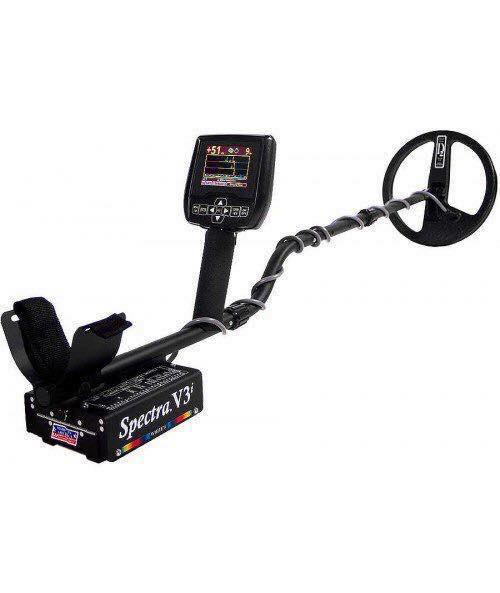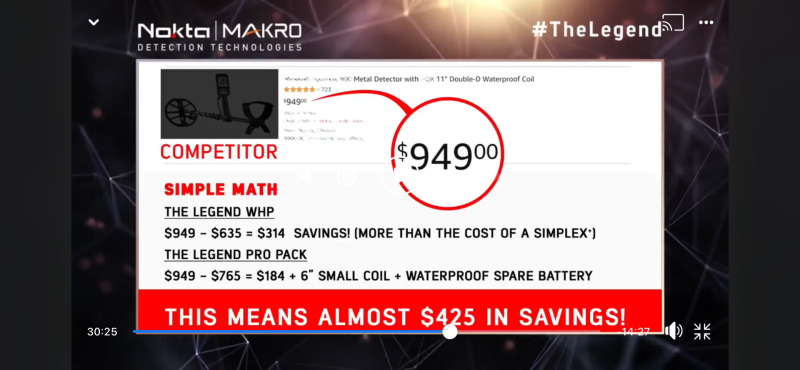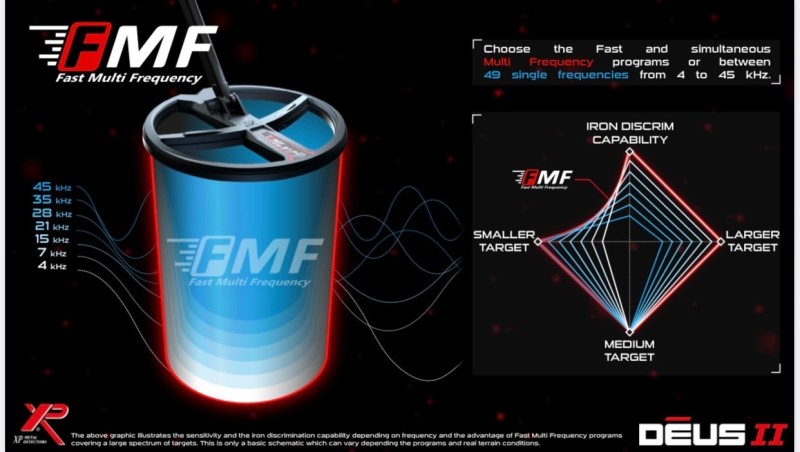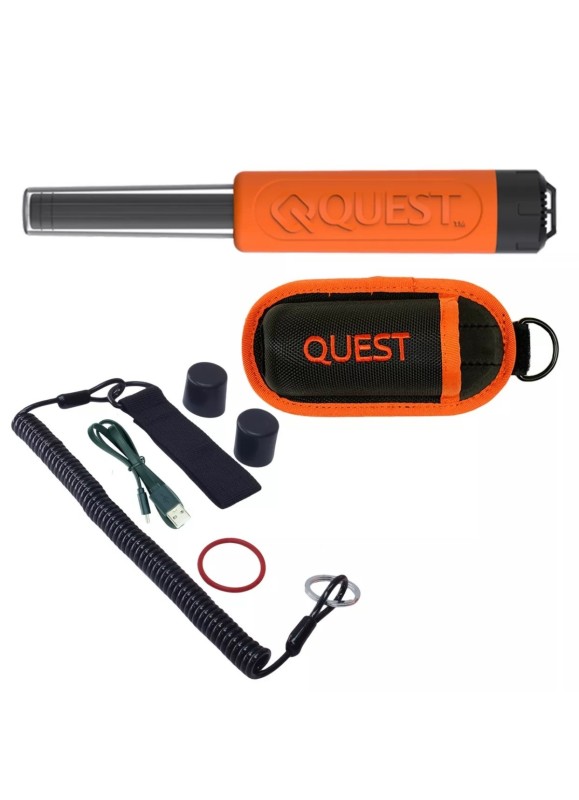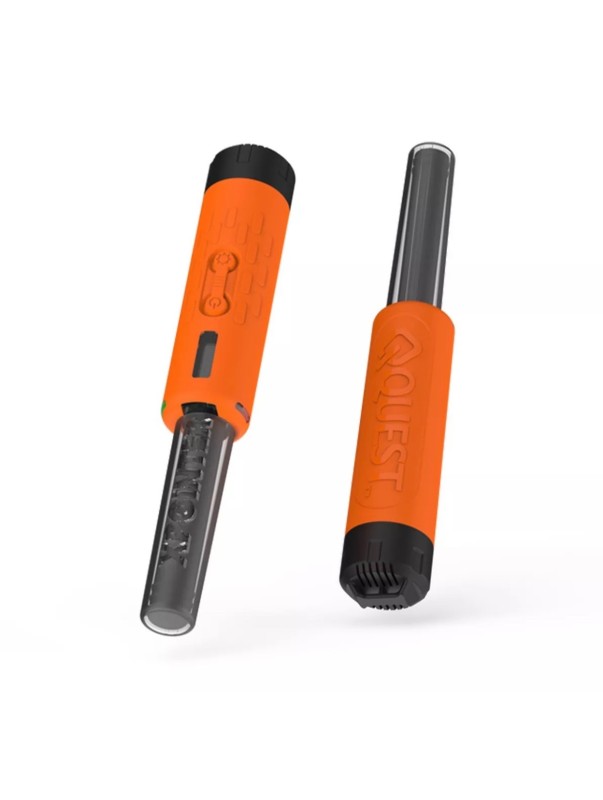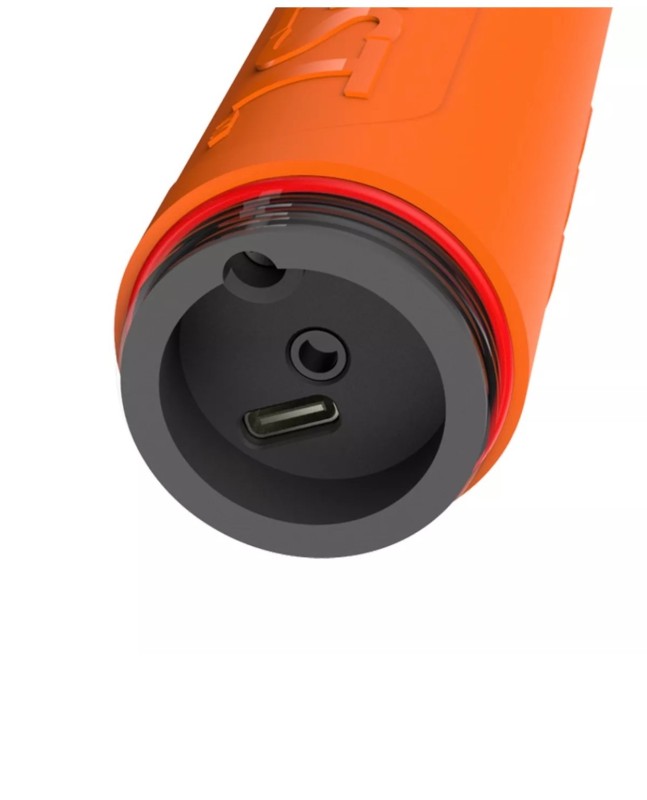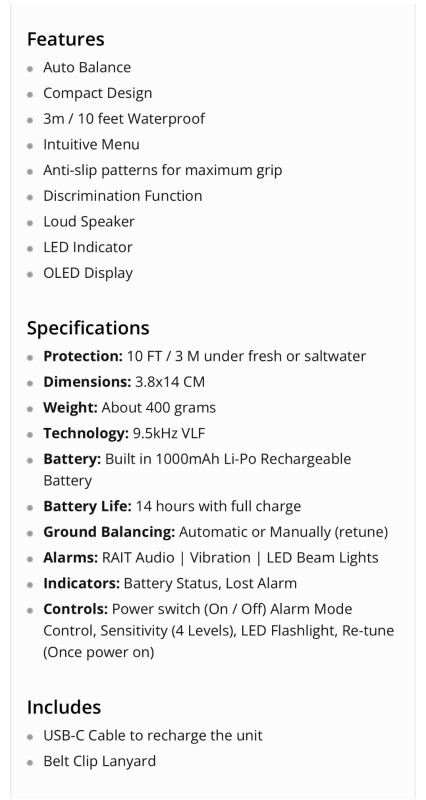-
Posts
658 -
Joined
-
Last visited
Content Type
Forums
Detector Prospector Home
Detector Database
Downloads
Everything posted by ☠ Cipher
-
The most compelling features in my mind are: Robust build Ferrocheck iron probability graphic (reminds me of fe:co in graphic form) Price Performance remains to be seen, and that will be the primary factor for me. The price really is something though. For less than the price of an Equinox 600 you get the features of an 800 and then some. If it performs comparably to an equinox 800 it’s going to be a force. $635. Even less than I expected. What will a used one go for? 500? Maybe less over time.
-

Detech 15" Ultimate For Simplex
☠ Cipher replied to Steve Herschbach's topic in Nokta / Makro Metal Detectors
Great news. I’m a big fan of the Ultimate coils. What the 13” did for my V3i was amazing. It became a whole different animal. When I first got my Simplex one of the first things I did was run it through depth tests. I was less than impressed and I didn’t even get my expectations up as high as most people did. I wasn’t seeing fringe depths from it in air or in ground. So I looked through some more videos. Sure enough, there were air tests where it was doing significantly better for others than for me. The kind of finds it was pulling up for people seemed indicative of a deeper machine. I began to think I got a bum unit or a bum coil. Then one day I balanced on a new patch of ground. It came alive and was like a whole new machine in air and in ground. None of my other machines have ever been as picky about its ground balance as Simplex and why it should’ve affected the air testing to such a degree is a mystery to me, but I’ve confirmed it over and over. If the patch of ground I balance on is not super exceptionally clean depth suffers both in air and in ground. Problem is the patches of ground I balance on are all silent, giving no indication it’s not clean enough. I guess It just doesn’t like something in the composition in some places. I know there’s a lot of very fine rust in my home soil, but another funny thing about Simplex is it reads my soil as 0-2 bars. 0 most of the time. My past F75s always read it as 2-3 bars consistently. These things would bother me more if it didn’t hunt as well as it does now provided I get a patch of ground it likes. If I do, it’s as deep as an F75. If I don’t it’s more like an F4. It just seems to read the ground in a weird way to me at least. Just something I wanted to pass on to you. -
Only if you plug it into the ML-08, but then it’s not truly the kind of wireless most of us like.
-

The Curse Of Oak Island And The Minelab Ctx-3030
☠ Cipher replied to ☠ Cipher's topic in Metal Detector Advice & Comparisons
I love Detectorists. Sad they didn’t make any more seasons. I am just like Lance with my equipment. Anyone who want to see me itch and crawl out of my skin only has to pick up one of my machines and start playing around with it. Once in a while I will learn something very valuable from some of YouTube testers. Scannerguy68 taught me something about how to work the V3is 3 frequency pinpoint no motion among commingled targets I’ve never forgotten. I’ve been using it ever since still amazed at how it turned one of the Vs weaknesses into a hidden strength. Gary is primarily a beach hunter on the Florida treasure coast. Makes me wonder how they discovered him and decided to bring him aboard. They could’ve had anybody they wanted. Might just be the personality. He’s like their pet Englishman. They seem to get a kick out of the accent more than what he’s actually saying haha. -

The Curse Of Oak Island And The Minelab Ctx-3030
☠ Cipher replied to ☠ Cipher's topic in Metal Detector Advice & Comparisons
I look at them as complimentary as well. To me they fit like a lock and key in terms of their abilities. It’s a deadly duo. I cannot wait to see what Minelab comes up with combining the best of these technologies. -

The Curse Of Oak Island And The Minelab Ctx-3030
☠ Cipher replied to ☠ Cipher's topic in Metal Detector Advice & Comparisons
I can’t believe that escaped my eye. I’m so used to seeing him with the CTX-3030 with 13”x17” coil that either I conflated the image or I wasn’t looking at all. It’s actually nice to see. I brought up this topic partly because the show is what pushed me over the edge into metal detecting. I’d always been curious and fascinated by treasure hunting. My best buddy had also gotten a metal detector and was showing off his finds to me. That got me motivated, but the show gave me that extra nudge into buying my first metal detector. When I first started out I dreamed about owning a machine like the CTX. I started at the bottom of the lineup and worked my way up to the machines I have today. But as I learned more about metal detecting and metal detectors the further down my list of priorities the 3030 slipped. Just as I was about to start looking for a used unit the Equinox came on the scene and pushed it further back. I can say that comparing what my expectations were about what a metal detector could do starting out to the reality of the technological limitations was a bit of a let down at first, but I got over it pretty quick. Yet I think those expectations colored how I approach metal detecting (on land) today. From the beginning My goal most days has been to make the best use of my time by limiting the amount of trash I dig. This has me primarily focused on the silver range, not always, but most of the time. NY is just not a gold bearing state unfortunately. With this in mind, eventually I couldn’t resist buying a CTX-3030. Given that it has the same fundamental limitations as every other machine, I never valued it at $2,500. I jumped on one at $1,100. The story behind it was very familiar to me. The Curse of Oak Island inspired the previous owner to take up metal detecting and he wanted the machine he saw on the show. Like myself starting out, he had unrealistic expectations about what it could do. The difference was he never joined or consulted the forums to find out more about everything before buying it. By the time I bought mine, I knew what I was getting. Bottom line on the purchase is at my price I don’t regret it. Though the Equinox is more versatile and well rounded, and I wouldn’t necessarily trade it for a CTX, I can say the CTX-3030 next to the V3i are two of the most fun machines I’ve ever used. When given to the tasks they are best at, I just have a blast with them. Primarily they have become my isolated target field machines and my cherry pickers. Equinox for everything else. It’s hard to believe 9 years have passed since the first season. In that 9 years I have to imagine the Curse of Oak Island has played a role in growing the hobby. I hear a similar story as mine reflected back at me quite often both from those just passing through and those who’ve stuck with it. I only wish I’d discovered the hobby earlier even if you told me when Oak Island first began, 9 years later they’d still be there and without solving the mystery. For those that stuck with the hobby, it truly is “the thrill of the hunt,” and “the fellowship of the dig” above all. -
Curse of Oak Island watchers will notice that after 9 seasons the Minelab CTX-3030 is still the machine of choice for the crew, particularly Gary Drayton. I know there has to be more people like me, bitten by the bug, watching and waiting to see if the Equinox would make an appearance. To date, it has not. Other than the occasional GPX-5000 clip, and some imaging hardware, CTX-3030 remains the primary detecting platform on the show, and often enough time is taken to point out the make and model being used. So one has to wonder, if not for The Curse Of Oak Island, where would the CTX-3030 be in light of the Equinox. I don’t claim to know how many CTX-3030s have been sold on the basis of the show, but I do know it’s not even close to none. It’s a significant amount, particularly among those wanting “the best.” People assume, rightly or wrongly, that the now elevated, popular show and a “metal detecting expert” like Gary Drayton would not be using anything less than the best. You don’t have to go far into various threads to realize a lot of people have sat up to take note of what machine is being used, and have expressed a desire to own it. In various threads regarding current owners the show comes up quite often as a basis motivating their purchase. The continuing high price tag of the unit, at $2,500, seems to confirm their impressions. Is it reality though? Can the CTX-3030 still be considered the best or one of the best? Clearly, metal detecting manufacturers have all but ignored it, setting their sights instead on the Equinox. If you were to take away the color display of the CTX-3030, and just look on paper, and at field results, you begin to wonder. The CTX makes the claim that it utilizes a full band of 28 multiple frequencies from 1.5khz to 100khz. Field results and independent spectral analysis does not support that claim. Rather, it seems to utilize one 3.125khz fundamental frequency and one 25khz harmonic frequency in each and every mode, leading to a bias toward deep silver, and user feedback that the unit is weak on fine gold; results that are entirely what you’d expect in light of the spectral analysis. Enter the Equinox. The Equinox was an obvious redress of some of the most common feedback about the CTX-3030 and other BBS/FBS multifrequency units, mostly that they were slow to recover and overlooked fine gold. It may have also been a response to those who had chosen the V3i over FBS platforms claiming they could get the best of both single frequency and multifrequency worlds. The Equinox now offered a range of single frequencies, which the CTX doesn’t, and mode/task tailored frequency blends, whereas CTX frequency weighting never varied from mode to mode, instead depending upon other settings to vary performance. The Equinox retained the ability to seek out deep silver, while gaining the sensitivity to seek out gold fine enough to make it a competent prospecting unit. With a new approach to recovery speed the Equinox could now hunt among commingled sites in a way CTX couldn’t according to many users. While there’s no shortage of those insisting the CTX-3030 is still the best (often citing the high tag rather than its ability), there’s also no shortage of those claiming to have dumped the platform in favor of their Equinox. There’s also those in the middle, claiming a marriage of sorts between the two platforms would be detecting nirvana. What say you? Is the CTX-3030 still one of the very best? Is it still worth $2,500 in light of the Equinox? Did the Curse of Oak Island ever shape your or anyone you knows initial view of the CTX-3030?
-
I always set limits on what I’m willing to pay, and I’ve been pretty good at sticking to my guns over the years. Sometimes it means I’ve waited longer than I wanted to for a detector, but more often than not, because I do keep such a vigilant eye out for what I want, I get what I want at the price I want. For a used Deus 1, particularly as Deus 2 becomes more widely available, I’d suspect we should be able to find the 35x versions for $600-$700 pretty consistently, and occasionally as low as $500. If Deus 2 doesn’t look like the unit for me, I’m going to bite on the first decent Deus 1 unit at $600. ORX doesn’t go up for sale much right now, once in a blue for $450-$550. As Deus 1 goes up for sale more often in light of Deus 2, so should the number of ORX people looking to sell ORX and move to Deus 1. One thing I can say for purchasing used and local is make sure when you decide on a unit you want, and what you’re willing to pay, that you keep it on you. Being prepared is a big advantage to beat the tire kickers and the unprepared to those super good deals. Many sellers are jaded, and appreciate someone who is ready, willing and able to just get the deal done straight away.
-
Simultaneous multifrequency shines best in saltwater environments, but there are some benefits to using it in mild ground. This is all theoretical, often nuanced, and at times depends on other factors. One is a more stable and reliable target ID and often to a greater depth. Depth in itself is a little trickier. Theoretically you should see a more consistent depth across the range of conductors, whereas single frequency tends to hit harder on conductors it’s particular frequency is tuned to and there tends to be a fall off in depth as you move away from that conductivity. If I were using an XLT at 6.5khz it should hit harder on Silver and depth would fall off on gold. This is one reason single frequency detectors began moving more in the 10-14khz range. Though theoretically this range hits hardest on mid conductors, it strikes a better balance in sensitivity across the spectrum. In my ground and in my freshwater swimming holes my 12khz Simplex would do just fine though if I didn’t have multifrequency options. The differences often seem subtle.
-
If it weren’t for the performance of my equinox and my curiosity about what the next gen multi-IQ platform will be like I’d be a lot more likely to gamble on being an early adopter of a Deus 2. I’ve saved a substantial sum for a next gen device whether it comes from Minelab, Garrett, Nokta Makro, or Deus 2, but I haven’t saved so much that I could buy all 4 in a short space of time. If the next gen Multi-IQ is the best of Equinox and CTX-3030, I all but know that’s the machine I’m going to want out of all of them. That’s the main event in my mind, unless Nokta Makro pulls a rabbit out of their hat on the 19th and releases a super fast V3 or V4 type of multifrequency. But the fact that everyone seems to be gunning for Multi-IQ tells me I’m in the right place for now. I’m going to spend wisely from here so that I end up with what I’d be happiest with when the dust clears.
-
It’s possible some of it may have caught them by surprise, like the coil ears etc. Could be partly due to an inconsistent compound. If you think back, from its launch the equinox was successful beyond their wildest dreams. I bought it brand new sight unseen myself because the technology and feature set was that alluring. I almost never do that. I usually let someone make a closet queen of it first. Anyway, it seemed unstoppable. Even when it reached the hands of users it seemed to meet the vast majority of expectations performance wise. If it weren’t such an exceptional machine the problems it’s had might’ve killed any other machine in a way it hasn’t come close to killing equinox sales. In a way it’s unfortunate because they weren’t forced to fix it. Now they have to contend with competitors who are not only nipping at their heels technologically, but who will be exploiting known, existing weaknesses until their next release remedies them.
-
I’ve considered this. I just wish Minelab had taken greater care to design the equinox in many ways. If they had, they might not be in the position they may now find themselves in. The technology itself is about all you could ask for in a machine that does it all. The housing just doesn’t seem to be worthy of holding that technology. It has left many a bitter user, and warded off many potential users out there when you comb through the comment sections. There are a good many people out there that were just waiting and hoping for this day, and many more yet waiting for the 19th. I just hope they’ve learned everything they need to learn for their next release. At the moment their strongest argument for the equinox is that the technology is proven. Deus 2 is an unknown, both in terms of retaining all the Deus 1 was and having equally effective multifrequency. Nokta Makro is even more of an unknown and have been seeming to try to differentiate their multifrequency as “true simultaneous” whatever that might mean.
-
Yes, what Phrunt said. I’ve never seen anything specific from Minelab either. That’s part of the problem. They’ve never stressed that there are time limits this. Hookahs are becoming more popular among water hunters and many of them allow us to stay under for quite some time up to depths of 30 feet. I’m also not saying there’s not some defect of design, just wondering how many might be due to exceeding limits many might not even be aware exist. A lot of companies in general are guilty of omitting this information, figuring most people won’t come close to exceeding the standards I’m guessing. The dubious waterproofness of the Equinox is one reason I bought a Simplex. I’m not afraid of damaging it as much and let’s face it, Nokta Makro doesn’t seem to be having these problems to any degree worth discussing anyway. I personally have never had a problem with Equinox in any way, or any other equipment failures that seem to plague other users. But I also take care not to be hard on my stuff, no matter what it is, from my electronics to my metal detectors. Since my office and space for my equipment is right in the back of my living room everything has to come in clean as the day I bought it and neatly put away or I won’t hear the end of it.
-
I do wonder how many equinox breaches were due to users exceeding the limits of protection offered by Equinox. When I see IP68 rating to 10 feet I think nothing more than, “ok, it’s an all terrain machine.” It’s ok to submerge or dunk it for a bit, but not indefinitely. It’s not a diving rig. I think where Minelab goes wrong is by not stressing the time limit involved on submersion, which if I remember is around 30 minutes, and that what they’ve offered is not for diving for indefinite periods. But there are also users who know full well they are exceeding the limits, but continue to do it over and over rather than buying a true diving machine. There are users who do this in plain view on YouTube and then talk about how it’s their 3rd unit. I have one of the earliest Equinoxes and I dunk it every summer. Some of what I do with it could even be considered short diving. But I’ve never exceeded the depth or time limits suggested and never had a single problem. On the Tarsacci, I don’t think Deus will cut into what it does best. When the technology behind Tarsacci is described it sounds exactly like what it most likely is, Truncated Half-Sine. It’s a different animal than single frequency, multifrequency, or even pulse. My understanding of it is that there is something inherent in the way Half-Sine handles bad ground that couldn’t be replicated through traditional VLF or multifrequency. The nearest comparison would be Pulse, but then you trade off discrimination.
-
I’m going to go ahead and say something I’ve been thinking, whether it’s right or wrong, it’s something that’s been on my mind. Although there’s a part of me that would like to see a machine be all things for the sake of my own technological benefit, there’s also a part of me that hopes these naked attempts to simply follow and replicate Minelab’s hard work fail. Minelab saw the value in multifrequency 30 years ago and have been plugging away ever since. Multi-IQ and “fast multifrequency” just saw the light of day about 4 years ago. It seems unfair that others can just come in already and reap the benefits. There’s as much a part of me that is rooting for Minelab to remain where they have earned and deserve to be. My hope for other emerging platforms is that they come up with something innovative enough to call their own and not simply calling multi-IQ something else and repackaging it. I'm aware of all the devils advocate arguments, that this is how technology moves forward, and how many other instances there are for precedent etc. This is why I feel this way only in part. I know many others feel the same.
-
They certainly do. They might look at the CTX at $2,500 if they are young and strong and wanting color display, but it’s weight and lack of portability is readily apparent even in photos. There’s also the factor in the next paragraph and CTX is now almost 10 years old. People begin to call it “old technology.” But wanting the best is exactly why an experienced user knows they should hold on to their equinox for the moment. I want the best version of “fast multifrequency,” and on the chance that XP has not been able to capture what Minelab has done, I’m not going to make any hasty moves to part with my equinox and jump ship. It could very well be that XPs attempts to replicate Multi-IQ fall short as have everyone’s attempts to replicate what XP has done in iron infested sites. If this were to be the case, it would defeat the purpose in the Deus 2 platform for me. That being to have a Deus 1 and eat the Equinox too. I want to pack as much capability in one machine as is possible as my space to store multiple units is limited. Definitely does. I have to say, the XP lineup are the sleekest, most modern looking detectors on the market for many reasons. This is one advantage of a wireless coil too in a world where everything is wireless. The lack of cord helps give XP a more modernistic appeal. When I showed the Deus 2 to my wife, who is only somewhat acquainted with my personal detectors, she echoed this sentiment. I’m a weirdo too, but with me it’s more about being lazy. I don’t want yet one more thing to charge and keep charged. This becomes all the more annoying the more coils that are collected, not to mention expensive, as each new coil is also another metal detector. I also know that wireless is not the best and most convenient solution for water hunters, which I am. I do for the most part, and first/foremost consider wireless coils to be a futuristic novelty and marketing gimmick that works. For me, it’s why I’ve stayed away so long, however. It’s the performance in iron of the XP platforms that has me looking again.
-
It is very possible we could see something. It would be wise for any company with an updatable machine to hold some substantive features for a time like this, to renew excitement for your own platform and tamp down excitement for another. I don’t think that all new features necessarily need to be held over for an Equinox 1000 or whatever it ends up being called. What will sell the high end variant are frills, graphics and innovations the current equinox models couldn’t accommodate anyway. I wouldn’t expect them to drop anything right this moment, but after Nokta Makro drops whatever they are bringing to the table. Maybe they don’t think like me and nothing will happen until the next model, but it would seem like it couldn’t hurt as a PR move. These attempts to outdo their feature sets were I’m sure entirely predictable and I’d have something waiting for it. It will also be interesting to see how Minelab handles attempts to replicate their technology and how close these companies can get without crossing the line into patent infringement. As we’ve seen in the past, they’ve started legal proceedings over less. By spring of the coming year I’m sure I’ll give an XP product another try, I’m just not sure which one yet. It would take hearing incredible, exceptional things about Deus II for me to go the way of purchasing it brand new, hot off the shelf. It would absolutely have to preserve or improve on Deus 1 capability AND match equinox in multi. Short of that I will purchase a gently used Deus 1 or ORX and see what evolves with Deus II over time. If Deus 1 is any indication we will see many updates and revisions of software and features in the coming years. Time also presents more opportunities to score better deals. Nokta Makro’s SMF I’m sure will fall more into the category of something you can buy on impulse and not get beat up too bad for it. It too would still have to bring something different to the table. I’m not looking for a cheaper equinox or an equinox with 5 more kHz or more closely spaced single frequencies. It will take more than that. Even equinox had to bring new things or I wouldn’t have bothered with it in addition to my other SMF machines. It did. It brought fast multifrequency, greater sensitivity to low conductors, and in some cases better ground handling than what I had.
-
For me the Deus 2 has to be all that Deus 1 is plus match equinox performance. If it doesn’t do both then I’ll just snatch up someone’s used Deus or ORX as they attempt to upgrade to Deus 2. One thing is for sure. We are going to see a flurry of Deus 1 sales as early adopters throw caution to the wind.
-
Reasons to Hold on to Your Equinox Proven performance with frequency selection, and frequency weighting solutions proven in the field. 4,5,10,15,20, and 40khz cover the range of detecting scenarios. There are diminishing returns for frequencies over 20khz so that the difference between 40 and 45 is quite a bit more negligible than one would think, and effectiveness will boil down to other factors having to do with proper tuning; gain for example, as we have seen before. Minelab has done for multifrequency what XP has done for (digital) performance in iron infested and commingled sites. When one steps into the wheelhouse of the other we would be right to take a wait and see approach. Equinox came closer to, but did not match or eclipse Deus’ strengths in single frequency modes and I’m sure they tried. We should not assume Deus 2 will eclipse an Equinoxes strengths quite yet. In fact it’s a bit early to even assume Deus 2 will retain all of Deus 1 strengths. There’s a tightrope to be walked and compromises to be made trying to be all things to all people in every detecting scenario. Deus 2 underwater solution remains dodgy. The main advance comes in the form of the waterproof remote. Despite the repetition of “no cords” during the underwater promo, use of an antenna is still necessary, and we can debate about whether an antenna of this nature constitutes a “cord.” The lack of forthrightness here knocked my trust down a couple notches as it was perfectly clear the company intentionally created a buzz implying they had made a breakthrough here they actually had not. The fact however remains that a robust and secured cord remains the best solution for submersion underwater. Wireless solutions still do not exist and has not in fact been achieved for underwater metal detecting. Coil selection. Although Equinox coil selection is not what it could be if opened up to more 3rd party players, the coil selection at present is sufficient to cover a wider range of scenarios with 6” round, 5”x10, 11” round, 9”x14”, 12”x15” and 15” round selections. If the Deus 1 is any indication the wider selection here will always be the case. Save $650. Not an insignificant amount of money that could be spent on other detecting items (even an ORX). Honestly, I couldn’t come up with very much and reason 2 is a bit like throwing stones in a glass house. XP Deus 2 looks pretty good, and so it just remains to be seen if it truly is all it claims to be. What reasons can you think of to hold onto your equinox 800?
-

What Would You Be Willing To Pay For The Deus 2?
☠ Cipher replied to NCtoad's topic in XP Deus II Forum
Issue for me is more room than price right now. I used to have a full room available for metal detecting equipment and other technology. At that time I had up to 13 detectors. But everyone kept complaining that I’d disappear into my little man cave, so eventually I turned it into a walk in closet for the wife and integrated my office space into the living room. Now I only have space for up to 5 machines at a time. I can take on one more before I have to start giving up one to get one. So I have to choose carefully. If I take something on it has to do something different/better than those in my lineup. If the Deus 2 could truly be a Deus 1 and an equinox all in one I could take it on, part ways with equinox and still have room for one more. There’s no guarantee that it will be either of those things, however. There’s no telling what compromises had to be made to make Deus 2 what it is. Minelab couldn’t replicate Deus 1 performance in single frequency modes on equinox, and I’m sure they tried. As long as I have this sorted out by Spring I’ll be fine here in NY. There’s only days to weeks of detecting left here before the ground becomes too hard to cut through. I’m very eager to see Deus 2 in some hands and what they can do as soon as possible. -
One question I have for you current XP Deus/ORX users is does the Deus II remote appear to be interchangeable with current shafts or is the shaft an entirely different configuration as well? One reason I ask is that one idea I kind of liked with the original Deus and now this one is that theoretically you can make two detectors out of one setup if you were to purchase a second coil. One could be paired with the remote, and the other with the “puck” provided you have another shaft laying around.
-
-
So after the XP Deus 2 debut, I’m not sure what to think yet. For me, whether I hold on to my equinox or not is going to boil down to how effective the Deus 2 is in multifrequency modes. The only thing I’m fairly sure of is that for me, and how I like to metal detect, so far my CTX and V3i with all their features will live to fight another day in my arsenal. Heavy as they may be these days compared to recent releases, I have no physical trouble swinging them as of yet. They continue to be worth what they bring to the table for me. Next for me is to see some testing and more specifics on Deus 2 and to wait and see what Nokta Makro brings to market.
-
On paper this appears to be a fairly impressive unit with the depth or range that the ProFind 35 lacks to be able to make an iron tone more effective. What feedback I’ve seen on it indicates this would equal the depth of pinpointers like TRX and Tek-Point, but with more features as depicted below. Has anyone here used one? What do you think so far? Personally the only thing that would make me think twice is that I already have powerhouse pinpointers and I’m not really looking to take on any new pinpointers that aren’t part of an ecosystem. While I’m impressed with this pinpointer on paper, I haven’t seen a full sized Quest machine that really floats my boat, particularly in light of the latest machines from the big players.

